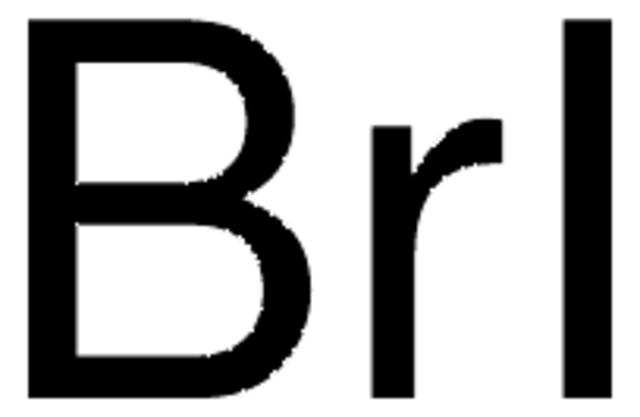481556
Iodine monochloride
99.998% trace metals basis
Synonym(s):
Chloroiodide
Sign Into View Organizational & Contract Pricing
All Photos(2)
About This Item
Linear Formula:
ICl
CAS Number:
Molecular Weight:
162.36
EC Number:
MDL number:
UNSPSC Code:
12352101
PubChem Substance ID:
NACRES:
NA.22
Recommended Products
Assay
99.998% trace metals basis
impurities
<25 ppm total metallic impurities
bp
97.4 °C (lit.)
density
3.24 g/mL at 25 °C (lit.)
storage temp.
2-8°C
SMILES string
ClI
InChI
1S/ClI/c1-2
InChI key
QZRGKCOWNLSUDK-UHFFFAOYSA-N
Looking for similar products? Visit Product Comparison Guide
Related Categories
Features and Benefits
Meets A.C.S. reagent specifications.
Signal Word
Danger
Hazard Statements
Precautionary Statements
Hazard Classifications
Eye Dam. 1 - Skin Corr. 1B - STOT SE 3
Target Organs
Respiratory system
Storage Class Code
8B - Non-combustible corrosive hazardous materials
WGK
WGK 3
Flash Point(F)
Not applicable
Flash Point(C)
Not applicable
Personal Protective Equipment
dust mask type N95 (US), Eyeshields, Gloves
Choose from one of the most recent versions:
Already Own This Product?
Find documentation for the products that you have recently purchased in the Document Library.
Ahmed Khalil et al.
Nucleosides, nucleotides & nucleic acids, 33(12), 786-799 (2014-11-06)
The reaction of thymidine, 3-mono-, and 3,3',5'-trialkylsubstitued thymidine analogues with iodine monochloride (ICl) was investigated. Treatment with ICl resulted in rapid deglycosylation, anomerization, and isomerization of thymidine and 3-substituted thymidine analogues under various reaction conditions leading to the formation of
Cation radicals as intermediates in aromatic halogenation with iodine monochloride: solvent and salt effects on the competition between chlorination and iodination.
Hubig SM, et al.
The Journal of Organic Chemistry, 59(21), 6233-6244 (1994)
Ultrasonic-assisted synthesis of flavones by oxidative cyclization of 2'-hydroxychalcones using iodine monochloride.
Lahyani A and Trabelsi M.
Ultrasonics Sonochemistry, 31, 626-630 (2016)
Polymethylbenzene complexes of iodine and iodine monochloride.
Andrews LJ and Keefer RM.
Journal of the American Chemical Society, 74(18), 4500-4503 (1952)
R G Nielsen et al.
Journal of chromatography, 423, 41-50 (1987-12-25)
Low-level adsorption on the stationary phase has been studied using immunochemical reagents. An immunoaffinity column has been evaluated using affinity-purified radioisotope-labeled monoclonal antibodies. Recovery experiments including continuous immunosorbent monitoring have been performed. Proper characterization of an immunoaffinity separation can result
Our team of scientists has experience in all areas of research including Life Science, Material Science, Chemical Synthesis, Chromatography, Analytical and many others.
Contact Technical Service







